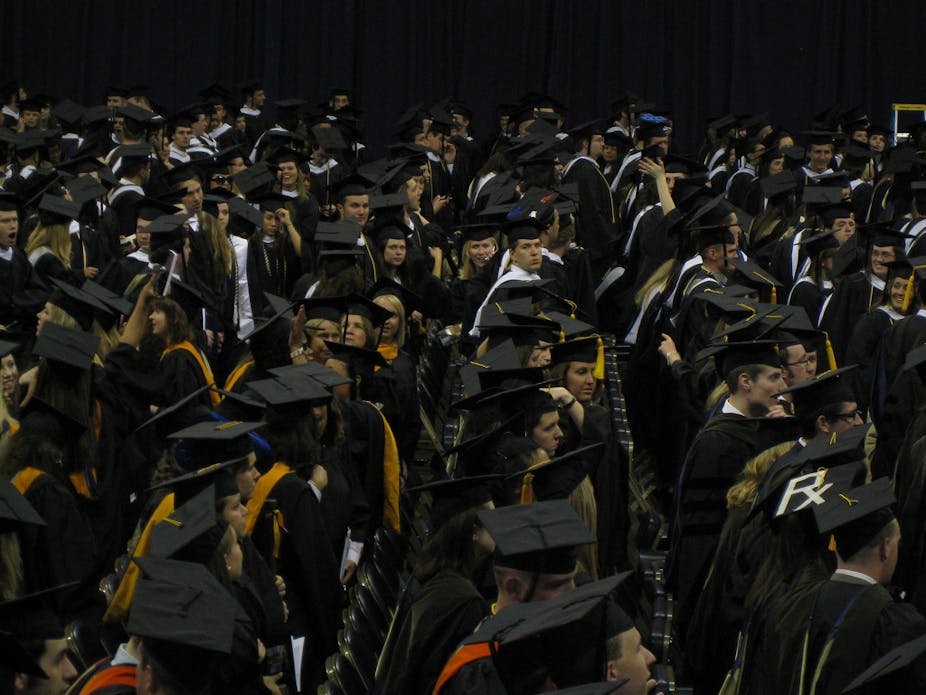Contrary to fears of falling enrolments in the sciences, the proportion of students taking science at Australian universities has been remarkably stable over the past half century: in 1962 16.4 per cent of university students studied science, rising a touch to 17.2 per cent in 2010.
This is among the findings of the Grattan Institute’s 85-page report, “Mapping Australian higher education”, released this week. Report author and Grattan Institute higher education program Andrew Norton also found that arts enrolments were almost identical in 1962, at 29.1 per cent, and 2010, at 29.2 per cent.
“In terms of people pursuing broad areas of knowledge, primarily done out of interest, rather than done for a vocational or professional outcome, it’s been more stable than people realise,” Mr Norton said. More vocational disciplines and courses such as IT tend to show marked fluctuations, as enrolment moves with what happens in the “real world”, Mr Norton said. “IT basically did not exist at Australian universities in the ‘60s, but by the late 1990s it had grown very big, and then there was a huge collapse 10 years ago when the Dot Com thing came to an end.”
In what Mr Norton said was a “curious trend that warrants further investigation”, the pass rates of commencing international students overtook commencing domestic students in 2009. The baton change came after rates for foreign students started climbing in 2005 and local students’ rates started falling in 2004. Mr Norton said the domestic phenomenon could be related to increasing numbers of lower SES students. In regards to the internationals, it was likely to be the result of intakes of students with higher English levels. “People were failing because they couldn’t understand, and when they do understand because they’ve got the language skills the pass rate, unsurprisingly, will increase.”
As discussed in the report, Australian academics and their students have a more distant relationship than their US counterparts, with Australian lecturers less enthusiastic about teaching and students reporting less lecture-inspired enthusiasm to work hard. When combined with this year’s deregulation allowing - and funding - universities to enrol as many domestic students as they see fit, there is a danger of some courses becoming more crowded and lecturers more harried. Mr Norton said there will be no formal quality checks required to maintain a certain level of educational experience, but rather it will be simply a “trust-the-system system”.
“You have to question whether expansion on the scale that we’ve seen in the last few years can be prudently accommodated,” Mr Norton said. “If staff are spread across too many people, it physically limits the amount of interaction they can have with students.”
RMIT University’s Principal Policy Analyst, Gavin Moodie, said that universities have overenrolled in the past, while a core deterrent has been fears of damaging the brand.“There are informal disciplines against universities enrolling too many domestic and international students: norms, reputation and regulatory threat.”
Norms about what is proper and good for a university infuse each institution “from the course co ordinator to the vice chancellor, all of whom have long experience and expertise as academics,” Dr Moodie said.
“The Australian Government has been very clear that it will re regulate universities, perhaps through institutional compacts, if their enrolments do not reflect the public’s interest. Similarly, the Australian Government has warned universities that their favoured immigration position will be removed if they enrol international students irresponsibly. Universities are very aware of these warnings and are on their best behaviour.”
“Nonetheless, some Australian universities have enrolled too many international students in the past and have over enrolled domestic students when they have been able to. So governments will have to monitor universities closely and act promptly if they abuse their freedom.”
The report includes dashes of history, tracking the Australian university sector’s transformation from being male dominated and founded not as research institutions but as places of scholarship that examined the perceived best of knowledge, with the first Australian PhD being awarded in the 1940s, and right up to this decade when research has well and truly trumped teaching in terms of priority, prestige, and boosting academics’ promotion prospects, and about 6,000 PhDs are awarded annually. Women have formed the majority of students since 1987.

